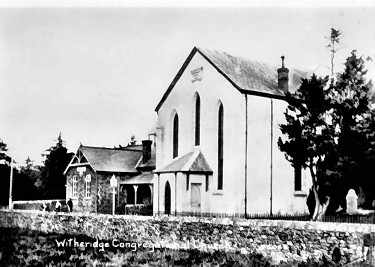

|
Sometime during the period 1818 to 1820 the Rev Thomas Sharp of Chulmleigh Congregational Church came to Witheridge and established a Sunday School for 30 scholars, one of whom was Mr Pullen. The Rev Sharp’s preaching brought great blessings and he was remembered by the Witheridge dissenters having brought the first seeds of Congregationalism to the village. Over the following years numbers grew, and by 1835 it was felt timely that they made greater effort to spread the Gospel, not only in Witheridge, but also in the nearby villages. To this end application was made to the Home Missionary Society in London for an Agent to care for the growing church, and this led to the appointment of The Rev William O’Neill, who arrived on 25th October 1837. On the first Sunday he preached in the morning at Templeton, in a house procured by Mr W Lake, at Puddington in the afternoon, and the evening service was held at Witheridge. A carpenters shop owned by Mr Henry Davey and situated in Witheridge Square had been rented for holding services, but such were the numbers attending that this proved far too small, and so before the end of 1837 the wish was expressed that a chapel should be built to serve not only Witheridge, but as a centre for the surrounding area. The Rev O’Neill set to work to raise the money required for the building. He first contacted all the leading persons in the locality, notably John Lake of Worlington who was especially encouraging both verbally and with liberal donations to the chapel building fund. All households in the neighbourhood were approached, and very few failed to offer help. Those who were to poor to offer money offered two or three days labour, and in this manner paid their share towards the building of their church. The Vicar of the Parish offered the first sovereign to the Rev O’Neill, and also offered to use his influence in finding a site for the building. There had been some difficulty with local landowners not prepared to assist the dissenters in obtaining the small amount of land required. However, in 1838 an Indenture conveyed a small plot of ground, part of Dyers Field to permit the building of a chapel. The foundation stone was laid on 28th June 1838, and a year later the church was opened on 20th June 1839. In 1845 the Church was registered for Marriages, and in 1899 a Marriage Register was obtained to comply with the new Marriage Act, and the Pastor was named as the Authorised person in accordance with the Act. The Chapel continued to prosper, and, to cater for the increasing numbers, and an End gallery was later added to provide seating for a further one hundred persons. In July 1845 the First Chapel (British) School was opened near the Square, and again the principal benefactor was John Lake, who gave a handsome donation to the building fund as well as £500 to be invested for the Schoolmasters salary and for half payment of the fees for a number of the poorer children. In 1898 a new school was build adjacent to the Church in Fore Street, and the old school became in turn a Drill Hall and later became the Church Hall for the Church of England. Mr John Lake also gave a plot of land adjoining the Chapel for use as a Burial Ground and in 1854 the freehold site for a Manse which he paid to be erected. This was sold in 1968 and the money invested for the benefit of the Church. Upon his death John Lake left Dyers Field to the Church and £200 in trust for the poor and sick members of the church, and was buried in the Chapel burial ground. In 1859 the Chapel candles were replaced with oil lamps, and in May 1831 Messrs Holcombe Bros installed electric lighting. The Font was presented to the el in 1969 by Captain and Mrs Field in memory of Mr and Mrs Partridge. Previous Last Edited 16/06/2007 Copyright © 2000-2006 Witheridge Unless otherwise indicated on the page in question, the photographic images reproduced on this site belong to the Witheridge Archives, and, as such may not be reproduced for commercial purposes without written permission. However, you are welcome to use any of the photographs belonging to the archive for personal and/or non-commercial use. Any material shown as not being owned by the archive may not be reproduced in any form without first receiving written permission from the owner of the material in question. |


